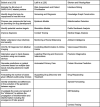Deep Learning applications for COVID-19
- PMID: 33457181
- PMCID: PMC7797891
- DOI: 10.1186/s40537-020-00392-9
Deep Learning applications for COVID-19
Abstract
This survey explores how Deep Learning has battled the COVID-19 pandemic and provides directions for future research on COVID-19. We cover Deep Learning applications in Natural Language Processing, Computer Vision, Life Sciences, and Epidemiology. We describe how each of these applications vary with the availability of big data and how learning tasks are constructed. We begin by evaluating the current state of Deep Learning and conclude with key limitations of Deep Learning for COVID-19 applications. These limitations include Interpretability, Generalization Metrics, Learning from Limited Labeled Data, and Data Privacy. Natural Language Processing applications include mining COVID-19 research for Information Retrieval and Question Answering, as well as Misinformation Detection, and Public Sentiment Analysis. Computer Vision applications cover Medical Image Analysis, Ambient Intelligence, and Vision-based Robotics. Within Life Sciences, our survey looks at how Deep Learning can be applied to Precision Diagnostics, Protein Structure Prediction, and Drug Repurposing. Deep Learning has additionally been utilized in Spread Forecasting for Epidemiology. Our literature review has found many examples of Deep Learning systems to fight COVID-19. We hope that this survey will help accelerate the use of Deep Learning for COVID-19 research.
Keywords: COVID-19; Computer Vision; Deep Learning applications; Epidemiology; Life Sciences; Natural Language Processing.
© The Author(s) 2021.
Conflict of interest statement
Competing interestsThe authors declare that they have no competing interests.
Figures






















References
-
- Worldometers. https://www.worldometers.info/coronavirus/. Accessed Jan 2021.
-
- Silver D, Huang A, Maddison CJ, Guez A, Sifre L, van den Driessche G, Schrittwieser J, Antonoglou I, Panneershelvam V, Lanctot M, Dieleman S, Grewe D, Nham J, Kalchbrenner N, Sutskever I, Lillicrap T, Leach M, Kavukcuoglu K, Graepel T, Hassabis D. Mastering the game of go with deep neural networks and tree search. Nature. 2016;529:484–503. doi: 10.1038/nature16961. - DOI - PubMed
-
- OpenAI Akkaya I, Andrychowicz M, Chociej M, Litwin M, McGrew B, Petron A, Paino A, Plappert M, Powell G, Ribas R, Schneider J, Tezak N, Tworek J, Welinder P, Weng L, Yuan Q, Zaremba W, Zhang L. Solving Rubik’s cube with a robot hand; 2019. arXiv:1910.07113.
-
- Brown TB, Mann B, Ryder N, Subbiah M, Kaplan J, Dhariwal P, Neelakantan A, Shyam P, Sastry G, Askell A, Agarwal S, Herbert-Voss A, Krueger G, Henighan T, Child R, Ramesh A, Ziegler DM, Wu J, Winter C, Hesse C, Chen M, Sigler E, Litwin M, Gray S, Chess B, Clark J, Berner C, McCandlish S, Radford A, Sutskever I, Amodei D. Language models are few-shot learners; 2020. arXiv:2005.14165.
-
- Bullock J, Luccioni A, Pham KH, Lam CSN, Luengo-Oroz M. Mapping the landscape of artificial intelligence applications against COVID-19; 2020. arXiv:2003.11336.
LinkOut - more resources
Full Text Sources
Other Literature Sources
